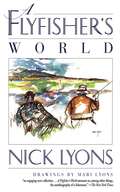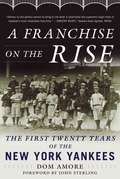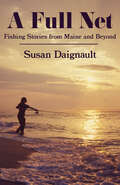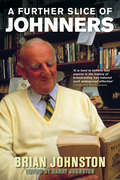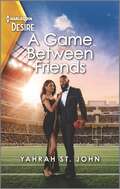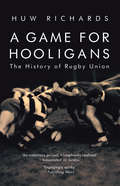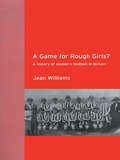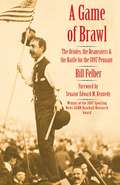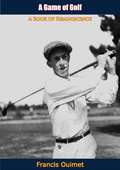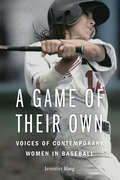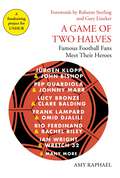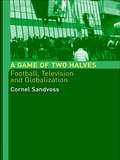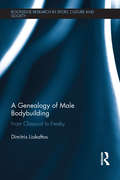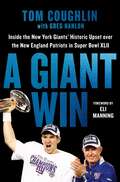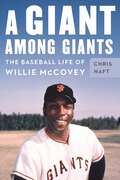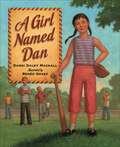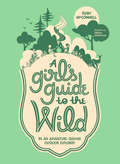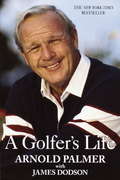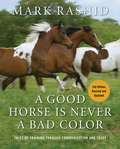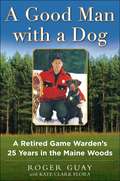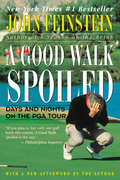- Table View
- List View
A Flyfisher's World
by Nick Lyons Mari LyonsThis ample selection of articles and essays by one of America's most popular writers about fly-fishing begins with a moment on Michigan's Au Sable River--the exact moment when the author lost his heart to fly-fishing. This collection chronicles a fishing life punctuated by a revealing trip with one of his grown sons and mellow reflections from a hospital bed.This is the broadest of Nick Lyons's books, with sections on tarpon and pike fishing in the Marquesas and in France, bass bugging on a small Connecticut pond, and trout fishing on unnamed creeks and blue-ribbon western rivers, as well as reflections on such aspects of the sport as the flies that are the underpinning of it all, the pursuit of records, the odd characters he's met along the way, and the increasing challenge of crowds who pursue this ever-popular sport.By turns canny, hilarious, inquiring, and philosophic, A Flyfisher's World is an impressive addition to Nick Lyons's important body of writing about fly-fishing.
A Forbidden Desire
by Robyn DonaldA scorching seduction?Jacinta knew as soon as Paul McAlpine opened his front door that she shouldn't stay. Gerard had warned her not to fall for Paul, his cousin, during her visit to Waitapu, New Zealand. But she already had-ten months ago! She'd kept her distance then, determined not to give into the compelling attraction she'd felt for this man. Now she faced spending a long, hot summer in Paul's company. How on earth was she going to deny their mutual, sizzling desire?
A Forbidden Seduction
by Sara WoodPassion in RebellionThe Colleoni family was bad news for Debbie. Her marriage to their son had turned out to be no marriage at all. Now she was alone, and fighting for her child's inheritance with his commanding and charismatic half brother-Luciano. Obviously she couldn't trust him, but a passionate attraction was flowing between them. She was vulnerable; she was under the disapproving glare of the Colleoni family; this seduction was foolish, taboo and...wildly irresistible!
A Franchise on the Rise: The First Twenty Years of the New York Yankees
by Dom Amore John Sterling2018 marks 115 years since the inception of the New York Yankees--and what a 115-year period it's been! But how did the team that has since won a league-leading 27 world championships get started? In A Franchise on the Rise, veteran sportswriter Dom Amore takes readers back in time to the first twenty years of the team's existence, from 1903 to 1923, focusing on all the major players and events, including their first ten years as the Highlanders, their move to Yankee Stadium, and their subsequent first World Series in 1923. In doing so, Amore successfully finds the characters' own voices and thereby vividly reconstructs events of more than a century ago. He recounts the snowy night Honus Wagner was offered twenty crisp $1,000 bills to join the new franchise in New York; the story behind the holes punched in the outfield fence that facilitated the stealing of signs in 1909; and why the team thought it may have had the next big superstar in a college football end named George Halas. This is a tale about the business of baseball as it was done at the time and, in many ways, as it still must be done. There was no secret to building a winning organization. It took money and luck, but it also took a group of people working as a team, each allowed to do his job and each doing it superbly.
A Full Net: Fishing Stories from Maine and Beyond
by Susan DaignaultSusan “Sue” Daignault was practically born with a rod and reel in her hand. Nearly from her birth, she and her family spent entire summers surfcasting for striped bass along the coasts of Massachusetts and Rhode Island. That love has followed her through her days in the Coast Guard and to her home on the coast of Maine and to some of the most beautiful, and fishy, places in the world. In her fun and fascinating new book, A Full Net, Sue shares with readers how she became “fish-brained,” and a woman increasingly driven to pursue everything from bonefish and tarpon to bass and, of course, stripers—wherever and whenever she could. What shines through all of her stories of success, failure, and friendship is a love for the waters of the world and the respect and admiration for the fish who call them home.
A Further Slice Of Johnners
by Brian JohnstonWhen Brian Johnston was a schoolboy, his reports were full of phrases such as 'talks too much in school' and 'apt to be a buffoon'. Later millions of radio listeners would be delighted to discover that some things never changed! Johnners brought his unique wit and personal charm to an enormous range of BBC radio and television programmes for nearly 50 years, from In Town Tonight and Down Your Way to Test Match Special. After Brian died in 1994, Christopher Martin-Jenkins wrote: 'It is hard to believe that anyone in the history of broadcasting has induced such widespread affection'. A Further Slice of Johnners covers Brian's early days, from his childhood in Hertfordshire and his schooldays at Eton and Oxford to his job in the family coffee business in the City and his service with the Grenadier Guards during the Second World War. There is also a selection of the most memorable characters and locations from his fifteen years on the Radio Four programme Down Your Way. Finally there is a collection of Brian's popular 'View From the Boundary' interviews on Test Match Special, including fascinating conversations with Eric Idle, John Major and Peter O'Toole.
A Game Between Friends: A friends with benefits romance (Locketts of Tuxedo Park #4)
by Yahrah St. JohnWill these former friends with benefits rekindle a flame…or settle scores? Find out in Yahrah St. John&’s Locketts of Tuxedo Park series finale!From lovers to friends to lovers again?It&’s complicated! After losing his football career due to an injury, Xavier Lockett found solace in the arms of singer Porscha Childs…until a misunderstanding tore them apart. Now a sportscaster at a top Atlanta network, the former star quarterback craves another taste of the woman who helped him turn his life around. But Porscha wants a hit record, not a second broken heart. Yet Xavier&’s still irresistible. The sparks between them ignite an inferno that lands her in his bed, but can she trust that this time they&’re both playing the same game?From Harlequin Desire: A luxurious world of bold encounters and sizzling chemistry.Love triumphs in these uplifting romances, part of the Locketts of Tuxedo Park series: Book 1: Consequences of PassionBook 2: Blind Date with the Spare HeirBook 3: Holiday PlaybookBook 4: A Game Between Friends
A Game for Hooligans: The History of Rugby Union
by Huw RichardsRugby union has undergone immense change in the past two decades - introducing a World Cup, accepting professionalism and creating a global market in players - yet no authoritative English-language general history of the game has been published in that time. Until now.A Game for Hooligans brings the game's colourful story up to date to include the 2007 World Cup. It covers all of the great matches, teams and players but also explores the social, political and economic changes that have affected the course of rugby's development. It is an international history, covering not only Britain and France but also the great rugby powers of the southern hemisphere and other successful rugby nations, including Argentina, Fiji and Japan.Contained within are the answers to many intriguing questions concerning the game, such as why 1895 is the most important date in both rugby-union and rugby-league history and how New Zealand became so good and have remained so good for so long. There is also a wealth of anecdotes, including allegations of devil-worship at a Welsh rugby club and an account of the game's contribution to the Cuban Revolution.This is a must-read for any fan of the oval ball.
A Game for Rough Girls?: A History of Women's Football in Britain
by Jean WilliamsCan we truly call football England's 'national' game?How have we arrived at this point of such clear inequality between men's and women's football? Between 1921 and 1972, women were banned from playing in football League grounds in the UK. Yet in 1998 FIFA declared that "the future is feminine" and that football was the fastest growing sport for women globally. The result of several years of original research, the book traces the continuities in women's participation since the beginnings of the game, and highlights the significant moments that have influenced current practice. The text provides: *insight into the communities and individual experiences of players, fans, investors, administrators and coaches*examination of the attitudes and role of national and international associations*analysis of the development of the professional game*comparisons with women's football in mainland Europe, the USA and Africa. A Game for Rough Girls is the first text to properly theorize the development of the game. Examining recreational and elite levels, the author provides a thorough critique, placing women's experience in the context of broader cultural and sports studies debates on social change, gender, power and global economics.
A Game of Brawl: The Orioles, the Beaneaters, and the Battle for the 1897 Pennant
by Edward M. Kennedy Bill FelberNot only was it probably the most cutthroat pennant race in baseball history; it was also a struggle to define how baseball would be played. This book re-creates the rowdy, season-long 1897 battle between the Baltimore Orioles and the Boston Beaneaters. The Orioles had acquired a reputation as the dirtiest team in baseball. Future Hall of Famers John McGraw, Wee Willie Keeler, and “Foxy” Ned Hanlon were proven winners—but their nasty tactics met with widespread disapproval among fans. So it was that their pennant race with the comparatively saintly Beaneaters took on a decidedly moralistic air. Bill Felber brings to life the most intensely watched team sporting event in the country’s history to that time. His book captures the drama of the final week, as the race came down to a three-game series. And finally, it conveys the madness of the third and decisive game, when thirty thousand fans literally knocked down the gates and walls of a facility designed to hold ten thousand to watch the Beaneaters grind out a win and bring down baseball’s first and most notorious evil empire.
A Game of Golf: A Book of Reminiscence (The\sportstown Ser.)
by Francis OuimetFrancis Ouimet (1893-1967) was an unknown twenty-year-old amateur when he upset famed British golfers Harry Vardon and Ted Ray to win the 1913 U.S. Open. That spectacular victory at The Country Club (TCC) made him America’s first golf hero, drew new fans to the sport, and forever altered the image of golf as a stuffy, rich man’s game dominated by British and Scottish players.In this engaging memoir, first published in 1932, Ouimet reminisces about his life in golf and gives sage advice on playing the game. He vividly chronicles the boyhood he spent at his modest home across the street from The Country Club in Brookline, Massachusetts. With charm and wit he recalls how he scavenged for golf balls and clubs, learned to play on a homemade, three-hole course in his backyard, and sneaked onto The Country Club’s fairways to practice in the early morning hours. He recounts his caddying years, starting at age nine, the early amateur competitions, and the momentous 1913 U.S. Open tournament on his neighborhood course.Legendary is the story of Ouimet and his caddy, Eddie Lowery. Ouimet refused an experienced TCC member’s offer to carry his clubs during the 1913 playoff in favor of the ten-year-old boy.Ouimet’s illustrious amateur career journeys across the fairways of Hoylake, St. Andrews, Garden City, and Pebble Beach, and concludes with his victory in the 1931 U.S. National Amateur at Beverly Hills in Chicago.Brimming with exciting matches and great players such as Bobby Jones and Walter Hagen, these humble reminiscences of the working-class kid who changed the game of golf will inspire golf enthusiasts and general readers alike.
A Game of Their Own: Voices of Contemporary Women in Baseball
by Jennifer RingIn 2010 twenty American women were selected to represent Team USA in the fourth Women’s Baseball World Cup in Caracas, Venezuela; most Americans, however, had no idea such a team even existed. A Game of Their Own chronicles the largely invisible history of women in baseball and offers an account of the 2010 Women’s World Cup tournament. Jennifer Ring includes oral histories of eleven members of the U.S. Women’s National Team, from the moment each player picked up a bat and ball as a young girl to her selection for Team USA. Each story is unique, but they share common themes that will resonate with young female players and fans alike: facing skepticism and taunts from players and parents when taking the batter’s box or the pitcher’s mound, self-doubt, the unceasing pressure to switch to softball, and eventual acceptance by their baseball teammates as they prove themselves as ballplayers. These racially, culturally, and economically diverse players from across the country have ignored the message that their love of the national pastime is “wrong.” Their stories come alive as they recount their battles and most memorable moments playing baseball—the joys of exceeding expectations and the pleasure of honing baseball skills and talent despite the lack of support. With exclusive interviews with players, coaches, and administrators, A Game of Their Own celebrates the U.S. Women’s National Team and the excellence of its remarkable players. In response to the jeer “No girls allowed!” these are powerful stories of optimism, feistiness, and staying true to oneself.
A Game of Two Halves: Famous Football Fans Meet Their Heroes
by Gary Lineker Amy RaphaelEver wondered which goal Frank Lampard is proudest of, who JÜrgen Klopp thinks will manage Liverpool in the future, what Rio Ferdinand thinks of Man United in the post-Ferguson years or exactly how many grey cashmere jumpers Pep Guardiola owns? In this collection of frank and funny conversations between soccer players and their biggest fans, these vital questions (and many more) are finally addressed. A Game of Two Halves shows a different side to some of the biggest names in the sport, reminding us of the common ground we all share. Profits from this project will be donated to UNHCR, the UN Refugee Agency, to support their work with child refugees. Featuring forewords by Raheem Sterling and Gary Lineker and interviews between JÜrgen Klopp and John Bishop, Pep Guardiola and Johnny Marr, Lucy Bronze and Clare Balding, Frank Lampard and Omid Djalili, Rio Ferdinand and Rachel Riley, Ian Wright and Wretch 32, HÉctor Bellerin and Romesh Ranganathan, Steven Gerrard and David Morrissey, Gary Lineker and Fahd Saleh, Eric Dier and David Lammy, John McGlynn and Val McDermid, and Vivianne Miedema and Amy Raphael
A Game of Two Halves: Football Fandom, Television and Globalisation (Comedia)
by Cornel SandvossProfessional football is one of the most popular television 'genres' worldwide, attracting the support of millions of fans, and the sponsorship of powerful companies. In A Game of Two Halves, Sandvoss considers football's relationship with television, its links with transnational capitalism, and the importance of football fandom in forming social and cultural identities around the globe. He presents the phenomenon of football as a reflection postmodern culture and globalization.Through a series of case studies, based in ethnographic audience research, Sandvoss explores the motivations and pleasures of football fans, the intense bond formed between supporters and their clubs, the implications of football consumption on political discourse and citizenship, football as a factor of cultural globalisation, and the pivotal role of football and television in a postmodern cultural order.
A Genealogy of Male Bodybuilding: From classical to freaky (Routledge Research in Sport, Culture and Society)
by Dimitris LiokaftosBodybuilding has become an increasingly dominant part of popular gym culture within the last century. Developing muscles is now seen as essential for both general health and high performance sport. At the more extreme end, the monstrous built body has become a pop icon that continues to provoke fascination. This original and engaging study explores the development of male bodybuilding culture from the nineteenth century to the present day, tracing its transformations and offering a new perspective on its current extreme direction. Drawing on archival research, interviews, participant observation, and discourse analysis, this book presents a critical mapping of bodybuilding’s trajectory. Following this trajectory through the wider sociocultural changes it has been a part of, a unique combination of historical and empirical data is used to investigate the aesthetics of bodybuilding and the shifting notions of the good body and human nature they reflect. This book will be fascinating reading for all those interested in the history and culture of bodybuilding, as well as for students and researchers of the sociology of sport, gender and the body.
A Giant Win: Inside the New York Giants' Historic Upset over the New England Patriots in Super Bowl XLII
by Tom CoughlinFrom legendary Giants coach Tom Coughlin, an inside look at the unforgettable Super Bowl game that changed NFL history. In A Giant Win, Coach Tom Coughlin reveals the intricacies of football, sharing details only a coach would know. He also details relationships with some of the most iconic players from the Giants, including Eli Manning and Michael Strahan. A Giant Win provides a frame for Coach Coughlin to discuss his life in football—including his years with the Giants as an assistant coach in the late 1980s and 1990, when he helped win a Super Bowl working under Hall of Fame Head Coach Bill Parcells and alongside the coach he&’d oppose in Super Bowl XLII: Bill Belichick. A Giant Win is a fascinating self-portrait of one of football's most successful coaches during his signature game.
A Giant among Giants: The Baseball Life of Willie McCovey
by Chris HaftWillie McCovey, known as &“Stretch,&” played Major League Baseball from 1959 to 1980, most notably as a member of the San Francisco Giants for nineteen seasons. A fearsome left-handed power hitter, McCovey ranked second only to Babe Ruth in career home runs among left-handed batters and tied for eighth overall with Ted Williams at the time of his retirement. He was a six-time All-Star, three-time National League home run champion, and 1969 league MVP, and he was inducted into the Baseball Hall of Fame in 1986 in his first year of eligibility. Known as a dead-pull line drive hitter, McCovey was called &“the scariest hitter in baseball&” by pitcher Bob Gibson. Born in Mobile, Alabama, McCovey encountered daunting hurdles, such as Jim Crow laws that prevented him from playing organized ball as a youth and playing for Major League managers such as Tom Sheehan and Alvin Dark, who took a dim view of his abilities. But neither that nor other difficulties on the field—the platooning, the slights, the unrelenting injuries—seemed to affect McCovey, as he remained grateful to be playing baseball. McCovey was the most treasured Bay Area icon of all, a humble, approachable superstar who earned the admiration of seemingly everyone he encountered. McCovey&’s life wasn&’t measured in his home run and RBI totals, though those were impressive. His greatest significance lay in the warmth and respect he extended and which others reciprocated. These elements elevated McCovey to a pantheon where relatively few athletes reside. He remains synonymous with not just the team he ennobled but also the city he represented. In A Giant among Giants, the first biography of McCovey, who passed away in 2018 at the age of eighty, Chris Haft tells the story of one of baseball&’s best hitters and most-beloved players.
A Girl Named Dan
by Dandi Daley MackallDandi enjoys nothing more than baseball, and so after the boys at school tell her their lunchtime game is now boys only, she enters an essay contest hoping to become a bat boy for the Kansas City A's, not realizing the contest is for boys only. Includes author's note on Title IX.
A Girl and Five Brave Horses
by Sonora Carver Elizabeth LandSonora Carver, when she was 16 never dreamed that she would be in show business doing an act that was amazing and exciting. But when she ran into Dr. Carver, and saw the Diving Horses act, she fell in love. Sonora had a great life traveling the country, riding and doing shows, and loving the horses she worked with. Klataw, John the Baptist, Juda, Red Lips, Snow, and Lightning, all were her family and her friends. Then one day Red Lips did a very dramatic nose dive and Sonora hit the water with her eyes open and face first. Her life changed after that day and this is her story. This book was the inspiration for the movie "Wild Hearts Can't Be Broken".
A Girl's Guide to the Wild: Be an Adventure-Seeking Outdoor Explorer! (A Girl's Guide to the Wild)
by Ruby McConnellGirls belong outdoors! This handbook covers everything you need to get outside, including ideas for what to do, camping and hiking basics, body stuff in the wilderness, advanced skills like maps, weather, and first aid, as well as recipes, projects, activities, and profiles of inspiring outdoorswomen.Your definitive guide to getting outside--for girls ages 9-12! In addition to basic outdoor skills, this entertaining guidebook includes easy camping recipes, outdoor projects including science experiments and crafts, fun activity suggestions, and inspiring stories of diverse historical and contemporary outdoorswomen (such as Arunima Sinha, the first amputee woman to summit Mount Everest; Juliette Gordon Low, founder of the Girl Scouts; and Libby Riddles, first woman to win the Iditarod). The goal is to improve the quality of girls' outdoor time by increasing participation and independence, making them feel comfortable and safe, and giving them essential skills and knowledge. Charming and approachable, this book will encourage both reluctant campers and budding naturalists to go wild and embrace the outdoors.
A Golfer's Life
by Arnold PalmerThere has never been a golfer to rival Arnold Palmer. He's the most aggressive, most exciting player the game has ever known, a dynamo famous for coming from behind to make bold last-minute charges to victory. To the legions of golf fans known around the world as "Arnie's Army," Palmer is a charismatic hero, the winner of sixty-one tournaments on the PGA Tour and still going strong on the Senior PGA Tour. But behind the legend, there is the private Palmer--a man of wit, compassion, loyalty, and true grit in the face of personal adversity. Golf-crazy as far back as he can remember, Arnie followed his dad, "Deacon" Palmer, the head greenskeeper, around the Latrobe Country Club fairways; as a youth he played at dawn before the club members arrived (the only time he was allowed on the course); by the time he graduated from high school he was headed for the national circuit. His rise to fame was meteoric, and by the 1960s he had emerged as one of the few American athletes the public truly cared about--a vibrant, daring, handsome sports celebrity who attracted wild crowds and enormous television audiences whenever he played and whose charisma propelled the explosion of enthusiam for golf in the sixties.Writing with the humor and candor that are as much his trademark as his unique golf swing, Palmer narrates the deeply moving story of his life both on and off the links. He recounts his friendships (and rivalries) with greats of the game, including Jack Nicklaus, his enduringly happy marriage with Winnie, his legendary charges to triumph and his titanic disasters, and his valiant battle against cancer. Returning to the Senior PGA Tour with unmatched zeal after his recovery, Palmer reminded fans of his unfaltering heroism--and the world of golf is thankful.From small-town boy to golfing legend, Arnold Palmer has lived one of the great sporting lives of the twentieth century. Now, with the help of acclaimed golf writer James Dodson, he has created one of the great sports autobiographies of our time.From the Hardcover edition.
A Good Horse Is Never a Bad Color: Tales of Training through Communication and Trust
by Mark RashidIn A Good Horse Is Never a Bad Color, Mark Rashid continues to share his talent for training horses through communication rather than force. Rashid uses humorous, feel-good stories to relate his techniques of teaching horses by examining their view of the world. These stories deal with many aspects of buying, owning, and training horses with a special focus on those that are troubled and hard-to-train. The arrested development of horses like these, Rashid shows, is often a result of their trainers’ own lack of understanding of their unique psychologies. With stories that stress the importance of patience and understanding, this book is a must-have for compassionate horse trainers and owners. Tales of Arabs, appaloosas, and paints—mistrusted and mistreated because of their breed—will give readers a new perspective on these breeds and others. Sometimes, it’s the attitude that needs to be fixed rather than the horse. Rashid’s accounts of horses bound for slaughter because they were considered impossible to train will inspire you to give your own problem horse a second look. This new edition features added introductory notes for each chapter that contribute to a better understanding of Rashid’s philosophy and methods.
A Good Man with a Dog: A Retired Game Warden's 25 Years in the Maine Woods
by Kate Clark Flora Roger GuayA game warden’s journey from the woods of Maine to the swamps of New Orleans. When Roger Guay’s father died in a tragic fishing accident, a kind game warden helped him through the loss. Inspired by this experience, as well as his love of the outdoors, Guay became a game warden and certified K9 handler, beginning a successful career that would span twenty-five years and see him establish canine units as a staple of the game warden service. Guay takes readers into the patient, watchful world of a warden catching poachers and protecting pristine wilderness, and the sometimes CSI-like reconstruction of deer- and moose-poaching scenes. Guay searches for lost hunters and hikers, estimating that over the years, he has pulled more than two hundred bodies out of Maine’s north woods. His frequent companion is a little brown lab named Reba, who can find discarded weapons, ejected shells, hidden fish, and missing people.A Good Man with a Dog explores Guay’s life as he and his canine partners are exposed to increasingly terrible events, from tracking down hostile poachers to searching for victims of violent crimes, including a year-long search for the hidden graves of two babies buried by a Massachusetts cult. He witnessed firsthand FEMA’s mismanagement of the post-Katrina cleanup efforts in New Orleans, an experience that left him scarred and disheartened. But he found hope with the support of family and friends, and eventually returned to the woods he knew and loved from the days of his youth.
A Good Sport
by Linda B. Ross Monica GesueNorm and his mom go out for a swim. Just the kind of sport he enjoys.
A Good Walk Spoiled: Days And Nights On The Pga Tour
by John FeinsteinIn the highly acclaimed bestseller A Good Walk Spoiled, John Feinstein captures the world of professional golf as it has never been captured before. Traveling with the golfers on the PGA Tour, Feinstein gets inside the heads of the game's greatest players as well as its struggling wannabes. Meet superstars like Nick Price, who nailed a fifty-foot putt at the seventeenth to win the British Open, and Paul Azinger, who marked his return from a bout with cancer with an emotional appearance at the Buick Open. Go behind the scenes for Davis Love III's unforgettable come-from-behind victory in the Ryder Cup. In golf, Feinstein eloquently relates, the line that separates triumph from disappointment is incredibly fine. "One week you've discovered the secret to the game; the next week you never want to play it again".
